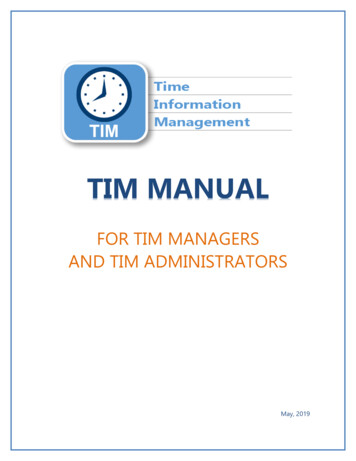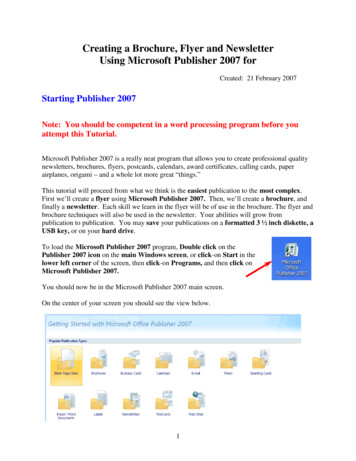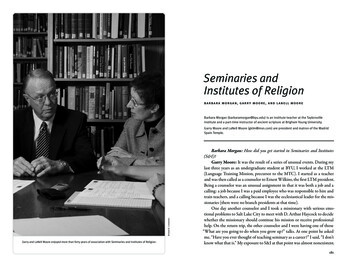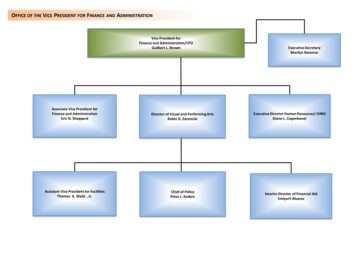
Transcription
Vice President, Publisher: Tim MooreAssociate Publisher and Director of Marketing: Amy NeidlingerExecutive Editor: Jim BoydEditorial Assistant: Pamela BolandOperations Manager: Gina KanouseSenior Marketing Manager: Julie PhiferPublicity Manager: Laura CzajaAssistant Marketing Manager: Megan ColvinCover Designer: Chuti PrasertsithManaging Editor: Kristy HartProject Editor: Betsy HarrisCopy Editor: Geneil BreezeProofreader: Water Crest Publishing, Inc.Senior Indexer: Cheryl LenserSenior Compositor: Gloria SchurickManufacturing Buyer: Dan Uhrig 2010 by HarmonicTrader.com LLCPublished by Pearson Education, Inc.Publishing as FT PressUpper Saddle River, New Jersey 07458This book is sold with the understanding that neither the author nor the publisher is engaged in rendering legal, accounting,or other professional services or advice by publishing this book. Each individual situation is unique. Thus, if legal orfinancial advice or other expert assistance is required in a specific situation, the services of a competent professional shouldbe sought to ensure that the situation has been evaluated carefully and appropriately. The author and the publisher disclaimany liability, loss, or risk resulting directly or indirectly, from the use or application of any of the contents of this book.FT Press offers excellent discounts on this book when ordered in quantity for bulk purchases or special sales. For more information,please contact U.S. Corporate and Government Sales, 1-800-382-3419, corpsales@pearsontechgroup.com. For sales outside theU.S., please contact International Sales at international@pearson.com.Company and product names mentioned herein are the trademarks or registered trademarks of their respective owners.All rights reserved. No part of this book may be reproduced, in any form or by any means, without permission in writing from thepublisher.Printed in the United States of AmericaFirst Printing May 2010ISBN-10: 0-13-705151-4ISBN-13: 978-0-13-705151-9Pearson Education LTD.Pearson Education Australia PTY, Limited.Pearson Education Singapore, Pte. Ltd.Pearson Education North Asia, Ltd.Pearson Education Canada, Ltd.Pearson Educatión de Mexico, S.A. de C.V.Pearson Education—JapanPearson Education Malaysia, Pte. Ltd.Library of Congress Cataloging-in-Publication DataCarney, Scott M., 1969Harmonic trading / Scott M. Carney.v. cm.Contents: v. 2. Profiting from the natural order of the financial —ISBN-13: 978-0-13-7051519-2 (v. 2 : pbk. : alk. paper)ISBN-10: 0-13-705151-4 (v. 2 : pbk.)1. Investment analysis. 2. Investments. 3. Portfolio management. I. Title.HG4529.C368 2010332.63’2042—dc222009051044
IntroductionAfter years of research, Harmonic Trading has evolved into a distinct and comprehensivemethodology that effectively analyzes the financial markets. The basic tenets of patternrecognition as quantified by harmonic ratios define a system that provides immensely pertinenttechnical information and identifies trading opportunities unlike any other methodology. It isimportant to consider the substantial advancement of Harmonic Trading since its inception.The release of my first book, The Harmonic Trader, marked the beginning of the entiremethodology. The new measurement techniques presented in this book quantified price actionin a unique manner. These new ideas created the framework of an unprecedented Fibonaccimeasurement and price pattern recognition system that consistently defined profitable tradingopportunities. Although it was not my intention to formulate such a system, these strategieswere the result of extensive research to discover the most effective relationships that wereencompassed by these measurement tools. Through it all, I precisely refined many generalconcepts and publicly divulged many “secret” strategies that comprised the fundamentals of theHarmonic Trading approach.The unprecedented combinations of specific ratios that differentiated similar price structuresas exact patterns defined an effective trading methodology, yielding relevant technicalinformation in an unprecedented fashion. Although others years before me have utilizedFibonacci ratios within the realm of Technical Analysis, the concept of exact ratio alignmentspresented a new means to define M-type and W-type price structures. These precise patternsoffered greater accuracy in the often vague discipline of pattern recognition for many traders.Although the rules that define harmonic patterns seem to be common knowledge today, itwasn’t too long ago that these strategies were practically considered avant-garde within thefield of Technical Analysis. This new application of Fibonacci ratios created a system of rulesthat defined price patterns in an unprecedented fashion. For example, the common definitionfor the Gartley pattern—requiring a 0.618 retracement and a 0.786 retracement at the B and Dpoints, respectively—which was originally outlined in The Harmonic Trader, has become thestandard within the technical community.These strategies have proven themselves effective through the years, but this success hasengendered many Harmonic Trading-related systems that have skewed the basic tenets of theapproach. These outfits have espoused the mystical charm of Fibonacci ratios to present more1
2Harmonic Trading: Volume Twoof a “secret code” to the financial markets than a proven system of measurement strategieswithin the discipline of Technical Analysis. Although I will address the problem of misinformationand unscrupulous “gurus” a little later in this Introduction, there are two critical concepts to bemindful of while studying this material: Harmonic Trading is more than Fibonacci. Anyone somewhat familiar with thismethodology understands that Harmonic Trading is much more than general Fibonaccianalysis. The entire Harmonic Trading approach comprises a variety of tools that includemore than simple Fibonacci measurement techniques and integrates a complex systemof execution and management strategies. Moreover, the new ideas presented in thisbook incorporate an even wider gamut of unprecedented trading tools. Harmonic Trading is still evolving. In my first book, I presented a number of technicalmeasurement strategies that quantified price patterns with respect to their alignment ofFibonacci ratios. The Harmonic Trader was unprecedented in that it was the firstmaterial to emphasize the importance of exact alignments and to employ specific ratiocombinations that differentiated a variety of patterns. Although The Harmonic Traderoutlined the framework of this methodology, Harmonic Trading: Volume Onerepresented a substantial advancement to the basic approach. Those two booksrepresent more than 500 pages of some of the most comprehensive pattern strategieswithin the field of Technical Analysis and dedicate a considerable portion of the materialto identification techniques, outlining the strict rules that validate structures as patterns.This book builds upon that foundation and improves upon the entire methodology tooutline effective trading strategies from start to finish.Since its release in 1999, many have tried to lay claim to the ideas that were first espousedin The Harmonic Trader. Despite other interpretations, Harmonic Trading: Volume One trulydistinguished this approach from the often misguided and misappropriated use of basicFibonacci strategies. Meanwhile, this book advances the basic tenets of Harmonic Tradingoffering greater “standardization” of pattern structures and improved confirmation strategiesthat optimize trading decisions.As these strategies evolve, there will continue to be a need for more thorough statisticalvalidation to improve the application of these methods and to enhance the overall accuracy ofthe approach. In fact, this is a driving principle behind the entire Harmonic Trading system—always improve upon what works. Although this may challenge the old adage: “If it ain’t broke,don’t fix it,” the effectiveness of this approach (and of any trading methodology) depends uponcontinual improvement. I offer comprehensive case studies throughout this material. I willcontinue to compile research to validate the effectiveness of the Harmonic Trading approach.Furthermore, new concepts such as the RSI BAMM and the 5-0 pattern represent substantialimprovements upon the initial foundation of this methodology.New Ideas in Harmonic TradingThe strategies outlined in this book are entirely new concepts that build upon the prior materialpresented within the Harmonic Trading approach. Many new topics will be presented withparticular emphasis on the Harmonic Impulse Waves, patterns within established trends, and
Introduction3BAMM Theory. In particular, the entire RSI BAMM strategy will be outlined. I will present newpatterns such as the 5-0, the Reciprocal AB CD, and the Alternate Bat. Although Volume Tworeferences many of the basic tenets of the Harmonic Trading approach, this material consistsof mostly new ideas and trading strategies. The new patterns and expanded measurementtechniques significantly advance the primary identification tools established within thisapproach. For example, the 5-0, the Alternate Bat, and the Reciprocal AB CD are importantnew structures within the existing array of harmonic patterns. Furthermore, these newstructures also comprise the basic framework of more advanced techniques. Hence, VolumeTwo represents a significant evolutionary step and an essential new direction that enhances theexisting methodology immensely.The most significant concept presented in this book and the most profound advancement ofthe entire Harmonic Trading methodology is outlined in the RSI BAMM methodology. This newcomplex system incorporates a standard technical indicator—the Relative Strength Indicator(RSI)—with advanced Harmonic Trading measurement techniques. The RSI BAMM employsprecise ratio measurements and exact structural pattern specification to identify criticaltechnical price levels. All of the material in Volume Two—especially the RSI BAMM—offersunprecedented strategies that identify the areas where overall trend divergence and harmonicpattern completions define the most critical technical levels. In addition, the new ideaspresented in this material advance the basic theory of price pattern recognition by requiringother technical conditions to exist to validate potential opportunities with improved accuracy.Specifically, the advancement of the RSI BAMM separates the minor reactive moves from themore substantial trading opportunities and provides extensive technical information regardingthe future potential direction of the price action. Although this material will take some time todigest, I believe these advanced concepts dramatically enhance the entire Harmonic Tradingsystem, furthering its efficacy in pinpointing the best trading opportunities.Technical Entities Continued In Harmonic Trading: Volume One, I discussed the importance of specific pattern alignments asdefined “technical entities.” It is important to note that the prescribed set of harmonic ratios thatdefine these structural entities has been differentiated, analyzed, and refined to developpattern-specific strategies for each situation. Although I covered it extensively in Volume One,it is important to remember that “The Great Gartley Controversy” emphasized the necessityof pattern differentiation and underscored the essential argument that not all patterns (Gartleys)are the same. New “technical entities” in the form of unprecedented harmonic price patternsoutlined in this book, such as the 5-0, the Alternate Bat, and the Reciprocal AB CD, furtherthe basic identification strategies of M-type and W-type price structures. These new patternsadhere to the primary principle of defining specific technical situations based upon theirrespective ratio alignments. Clearly, the material presented in Volume Two furthers thespecification of the Harmonic Trading methodology by offering a new level of strategic analysis.The improved measuring techniques enhance the precision and the overall accuracy of thisapproach in its ability to define the most critical turning points in the financial markets.
4Harmonic Trading: Volume TwoHarmonic Trading: Volume One was a major advancement of the principles of the primarypattern identification theory. The addition of unprecedented measurement techniques such asnew harmonic ratios, new patterns, and other comprehensive strategies, expanded the existingarray of effective trading tools and substantially bolstered the overall Harmonic Tradingdiscipline. Volume One presented a step-by-step approach with effective strategies for theentire trading process. From initial identification to trade execution to money management, acomprehensive plan was presented with each aspect thoroughly considered. In this regard, Ihave been pleased that this material provides a solid decision-making framework of probableanswers for all possible questions that might arise during the trading process. From patternidentification to the eventual execution of a trade, all possible actions have been outlined tofacilitate decisions, especially when unexpected real-time considerations can affect theoutcome.The material in The Harmonic Trader and Harmonic Trading: Volume One effectively definedthis system. However, through the years, I have continually strived to improve the HarmonicTrading approach and build upon this foundation. Hence, I present Volume Two. It is importantto note that the material within this book takes Harmonic Trading into new territory. Most of theideas outlined in Harmonic Trading: Volume Two are unprecedented, and they have not beenreleased previously in any other material. Volume Two advances the comprehensivemethodology of pattern identification presented in Volume One to incorporate new technicalmeasures that refine and filter the best trading opportunities. Advanced techniques, such asthe RSI BAMM, represent my most sophisticated trading techniques to date. It is my desire todistinguish Harmonic Trading as a serious discipline within the field of Technical Analysis. Suchdistinction has become increasingly important to me in recent years, as certain individuals haveattempted to capitalize on the burgeoning popularity of Fibonacci-related trading strategies,while tarnishing the inherent principles of Harmonic Trading.Imitators and AgitatorsI am compelled to discuss the importance of ethical and accurate reference informationregarding these techniques and for that matter, much of the educational material regardingtrading the financial markets available today. I have been disappointed with the misinformationand blatant misuse of the concepts first espoused within the Harmonic Trading approach. I’mwilling to accept this risk in exchange for the advancement of trading knowledge and for thepositive contribution to help others in search of the answers to the financial markets.When I first began discussing Harmonic Trading on various websites in the 1990s, I wasadmittedly naive. I openly shared strategies that advanced the basic Fibonacci trading mantraof that era. It was my desire to share with others in the hope that they would provide feedbackultimately furthering this discipline. Although I received a fantastic response from anoverwhelming number of traders, I realized that other Fibonacci-related “educators” werepicking up on the ideas, as well. I welcomed their response and actively sought to “talk shop”with these traders. Unfortunately, I quickly learned that most of these so-called educators were
Introduction5just teaching basic and somewhat vague Fibonacci strategies. These people promoted theirproducts by making absurd and controversial statements of phenomenal success. In fact, mostof these outfits were only in the business of selling products and not really trading. In someinstances, certain research of mine was presented as their own. I realized that I needed toexercise greater discretion and to strive to establish Harmonic Trading as a distinctmethodology apart from basic Fibonacci analysis.Harmonic Trading is a distinct approach to the financial markets within the field of TechnicalAnalysis. The main problem relates more to the misinformation or blatant manipulation of theintrigue and mystery that anything related to Fibonacci ratios inherently possesses. With therecent popularity of books such as The Da Vinci Code, the subject of mystical conspiracy-typestories that possess a secret order based upon the “golden proportions” of divine numbers hasopened a Pandora’s box of P. T. Barnums in the investment industry. Their ability to flourish andto attract the general public’s attention proves that the inherent curiosity regarding this subjectmatter can be an easy sell. It seems apparent that harmonic-related trading strategies havebecome an increasingly popular marketing slogan. Again, I must emphasize that the entire“harmonic concept” of pattern recognition based upon exact Fibonacci ratio alignments did notexist until The Harmonic Trader was released in the late 1990s. In addition, the entire subject ofFibonacci was a minor niche within the field of Technical Analysis. Harmonic Trading techniqueshave impacted the technical community and contributed to this recent popularity while othershave jumped on the coattails of this approach.For me, the degree of misinformation spewed to the public with catch phrases such as“market-harmonics, trading in harmony, harmonic secrets” have lumped a great deal of lessthan-credible information with the strategies that truly work. It is important for me to take a littletime to show some of the troublesome examples that have been offered to the public. I stronglyurge people to be cautious regarding outrageous claims of the effectiveness of any system thatwill make “quick riches” in the financial market, whether it is Fibonacci ratios or fundamentals.The problem with such claims, especially when the subject of Fibonacci is involved, is thatit is simply exploited for its marketing value. In this business, marketing is the key to sellingyour financial products, as I have unfortunately realized. Unlike many of the financial productvendors, I am not dependent on book sales to make my living. I do this because I ampassionate about trading the financial markets and the strategies that unlock its secrets.I strongly recommend that you perform thorough due diligence before signing up forseminars, purchasing software, or spending substantial money for educational products andservices that make outlandish claims. Believe me, Harmonic Trading possesses some of themost effective trading strategies available, but success still depends upon diligent anddedicated work to turn patterns into profits.Market Gurus AgainThese concerns lead into another discussion regarding my disdain for so-called market gurus.Anyone who purports to be a market guru must be cautiously regarded. Simply stated, there
6Harmonic Trading: Volume Twoare no market gurus. Let me repeat: There are no market gurus! In fact, many of these gurusare just people who have failed to be successful traders and have resorted to selling productsto make their living. It’s such a shame. It is so easy to believe these people and their hype. Myquestion is if they were really making money trading the markets with their methodology, whywould they spend the majority of their time selling products? In addition, it’s amazing to me thatthese guys have so much time to dedicate to the marketing of their financial products when themarket consumes so much time as a full-time trader. It can be difficult to know the real dealfrom the jokers selling their products just to make money. In my experience, after thoroughlyinvestigating many of these professionals—either going to their seminars or reading their booksand talking with them personally—you quickly realize who’s really trading and who is not. It’sunbelievable that many of these individuals get so much exposure in the media yet they rarelytrade and derive most of their income from selling products. If you want to find the mostpertinent material on successfully trading the markets, you must seek out the people whohave been or are in the business of trading.Even more incredulous is the number of people who have come to me after spendingthousands—if not tens of thousands of dollars—trying to learn how to trade from selfproclaimed gurus like these. Many of these people have been swindled out of their money whilenot learning any meaningful trading strategies. I believe that this is one of the greatest pitfallsas a beginner. Engulfed in a sea of (mis)information, it is easy to bounce from one system tothe next looking for the answers to the financial markets. I have been there—searching for theanswers to the market. Years ago, I struggled to find the best systems, spent thousands ofdollars on books and software, and lost even more money attempting to trade these fantasticsystems that held no real trading value. Sitting in front of my computer screen, I spentcountless hours researching the best techniques. I was willing to look at any approach thatproclaimed to have the answers to the market. Unfortunately, most of this research yieldedstrategies that failed to be reliable techniques in real trading situations.From a general perspective, I must emphasize that searching for the Holy Grail to thefinancial markets is just not a realistic approach to achieve consistent success. What is realisticis discovering the order within the chaos in the financial markets, defining that order and beingwilling to take some risk in return for financial reward. I’ve dedicated a substantial portion of mylife to the intensive study of the financial markets in an attempt to discover the best techniquesthat are consistently profitable. Through my years of research, I have put together a series ofbooks and a software program that is sufficient to help anyone learn the dynamics of harmonicprice action and provide a comprehensive method for effectively trading the financial markets.Whether you are a hedge fund manager with a billion in assets, a retiree trying to maximizeyour IRA, or a novice trader just beginning, I’m confident that these tools will help you decipherprice action better than any other system. In my opinion, the Harmonic Trading methodologyoffers some of the most reliable and pertinent technical information to identify profitableopportunities and interpret price action.
Introduction7Then Why Give It Away?Why give it away? I could simply retain these techniques for my own research and trading.However, I firmly believe that knowledge not shared is worthless. It does not matter that I havetaken the necessary legal precautions to protect my intellectual property. Although I ambothered by blatant plagiarism, it is my greatest desire to encourage an open and frankdiscussion of this material, while freely sharing this information with the public. The mostimportant reason why I’m releasing this book is that I truly want to set Harmonic Trading apartfrom all of the other Fibonacci-related strategies that have sprouted up in recent years. I believethat the advanced concepts within Volume Two demonstrate that Harmonic Trading is one ofthe most effective and reliable methods to understand the complex dynamics of the financialmarkets. The material in this book advances the entire system to a new level of accuracy andprovides even more effective trading strategies to achieve consistent success.It’s Still Up to You I can share these strategies, but the overall success is still dependent upon your dedication anddetermination to work diligently to follow the markets, analyze price action, and adhere to thismethodology. You must be willing to do the work. Although it can be easier to relinquish controlto an advisor or professional money management outfit, the ultimate responsibility for successin the financial markets is still up to each individual. The pursuit of market knowledge can bedaunting. But it is essential to refuse to allow anyone to deter you from the success that youseek.The ability to succeed in trading is 100% self-directed. You must find the opportunities,determine which trades to execute, and remain focused on your goals, as no outside elementcan distract you from your objective. Although this can seem overwhelming at first, HarmonicTrading does possess a comprehensive, start-to-finish methodology to successfully guide youthroughout the decision-making process. Despite sharing my most advanced research, it is stillentirely up to you to dedicate yourself to this endeavor to realize success.Although trading can be a solitary pursuit, it is important to remember that you know what’sbest for yourself—regardless of your level of experience. Many experts and their “immenselysuccessful systems” can be intimidating at first. It can be easy during the early stages oflearning any trading system to relinquish control of your own decision-making process to othersbecause they seemingly have better answers or appear to know more than you. Again, the truthis that only you know what’s best for yourself, and you must make your own assessmentsregarding any trading methodology. I encourage questions and welcome any comments and/orcriticism to extend an open debate regarding this material. Despite my own beliefs andpersonal success, I truly encourage you to evaluate this material for yourself.
8Harmonic Trading: Volume TwoThe Benefits of Advanced Harmonic TradingTechniquesI have always said that Harmonic Trading and the pattern identification techniques in particularwithin this approach are merely a starting point. These techniques serve as a comprehensiveframework that accurately measures and analyzes price action. The ultimate objective of thisbook attempts to outline specific technical situations within the course of trading that will yield ahigh degree of reward while minimizing risk. Advanced Harmonic Trading techniques can offerinformation regarding the potential state of price action unlike any other methodology. Whencombined with other technical studies and analyzed within the predominant trend, HarmonicTrading strategies can pinpoint the potential “hot spots” where reversals may complete orimportant continuations of the prevailing direction may develop.The combination of pattern identification techniques and the utilization of Fibonacci ratios toquantify price action is the greatest asset within the Harmonic Trading approach. As thismethodology has become more refined, I’ve realized that there are many other technicalindicators that form repetitive patterns in the same manner as price action. In the past, I tendedto be exclusive in the application of other technical measurement tools with harmonic pricepatterns. However, I began to notice over time how frequently many of these indicators wereacting as valid confirmation signals in conjunction with the basic pattern recognition techniques.Although many of these integrative strategies are simple applications of standard indicators, thecombination of these existing measures with the Harmonic Trading approach yielded moreaccurate technical information.The advanced Harmonic Trading strategies offer immense confirmation signals, and theyhave led to more precise executions within a pattern’s Potential Reversal Zone (PRZ).Essentially, the integration of other measures has resulted in even more accurate projectedreversal points for trade executions and hence, more reliable technical information regardingthe state of potential price action. At first, the simple integration of many of these indicatorreadings was generally beneficial. However, as I expanded the use of other technical indicators,I noticed many similar harmonic traits that formed in the indicator readings as did in the actualprice action itself. Once I began to see these relationships, I thoroughly explored a variety ofindicators to find those that correlated best with the Harmonic Trading techniques and providedthe most accurate confirmation signals to validate patterns.The Best of the BestThis book like the others has been years in the making, and it represents a collection of mybest ideas. I’m proud of this book because the techniques that I present in this material aretruly original within the field of Technical Analysis. While combining the basic approach ofseveral established technical methodologies, I believe the new ideas in this material integratethe existing unprecedented strategies of Harmonic Trading to create one of the mostcomprehensive and effective trading systems available today.
Introduction9It is important to note that I only release strategies that I have tested thoroughly in realtrading situations that have produced consistently successful results for me. In my opinion,successful strategies must stand up in real market conditions that reflect the realities of tradingand not just shine in well-chosen examples at a weekend trading seminar. I understand thatmany products and services, especially Fibonacci-related ones, make absurd claims of fortuneand success if you spend “only 15 minutes a day.” NO! I make no false promises of quickriches. I offer effective trading tools that help those people who are looking for the answers tothe financial markets, as long as they are willing to study and apply themselves through diligentwork to achieve consistent success.My goal in this book is to present a significant advancement of the Harmonic Tradingapproach that integrates new applications of existing technical measures beyond their standardinterpretation. In fact, the extent of new ideas and concepts practically doubles the existingamount of material on the subject. The advanced techniques outlined in this book incorporateonly the most pertinent technical measures that substantially increase the accuracy ofharmonic patterns to identify the critical turning points in the financial markets. In particular, theRSI B
methodology understands that Harmonic Trading is much more than general Fibonacci analysis.The entire Harmonic Trading approach comprises a variety of tools that include more than simple Fibonacci measurement techniques and integrates a complex system of execution and management strategies. Moreover, the new ideas presented in this
![WELCOME [ montclair.edu]](/img/31/commencement-program-2022.jpg)










